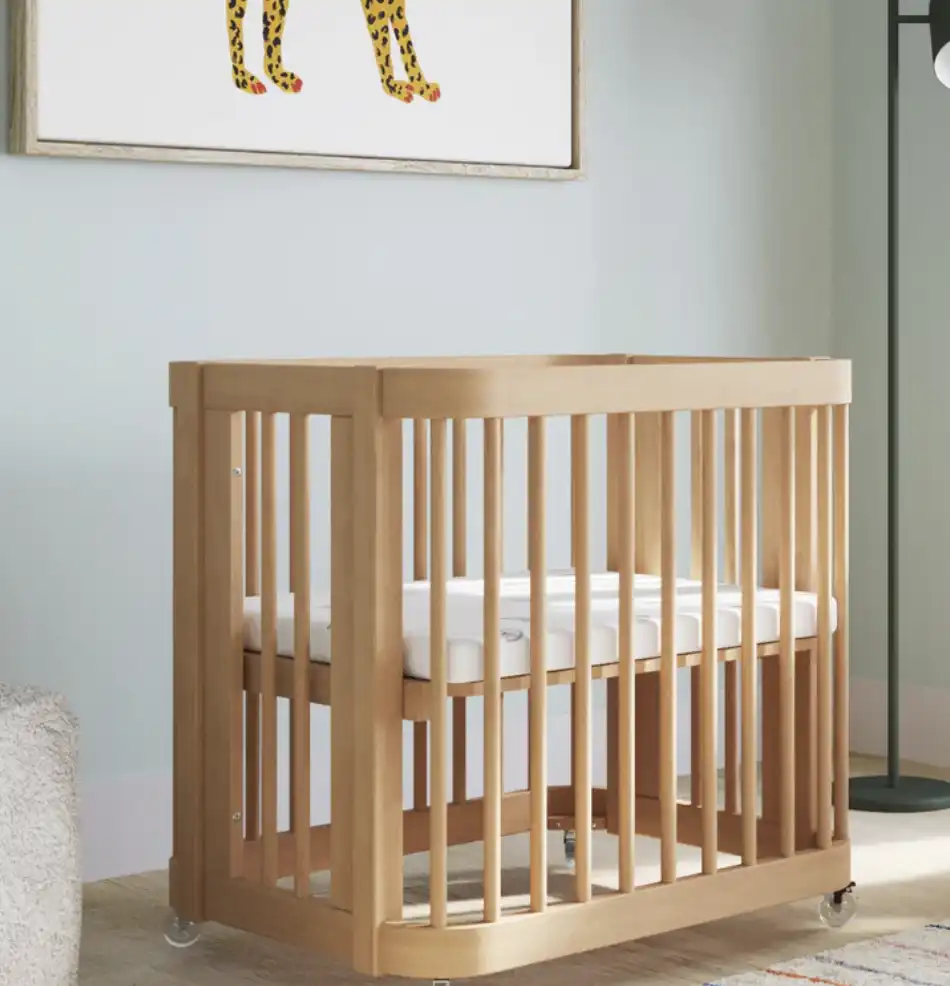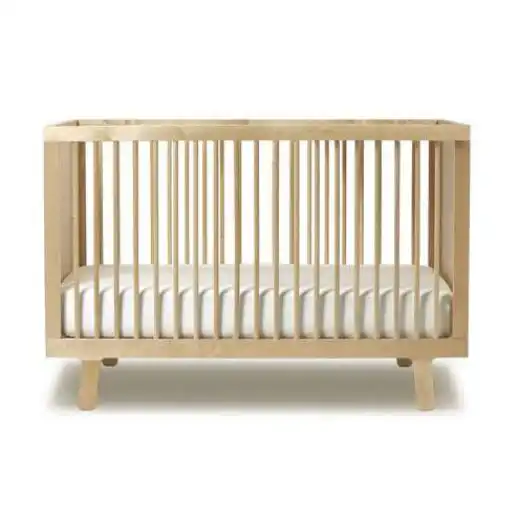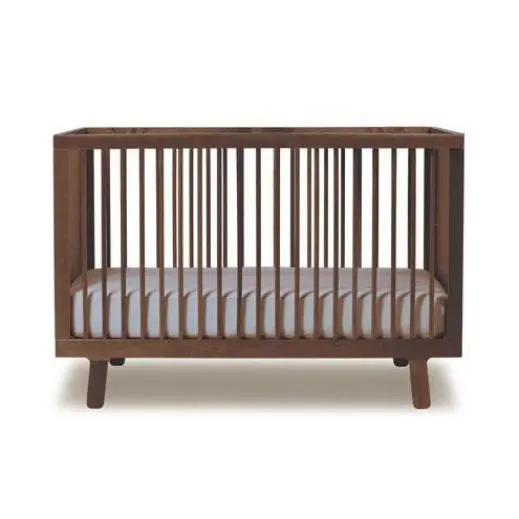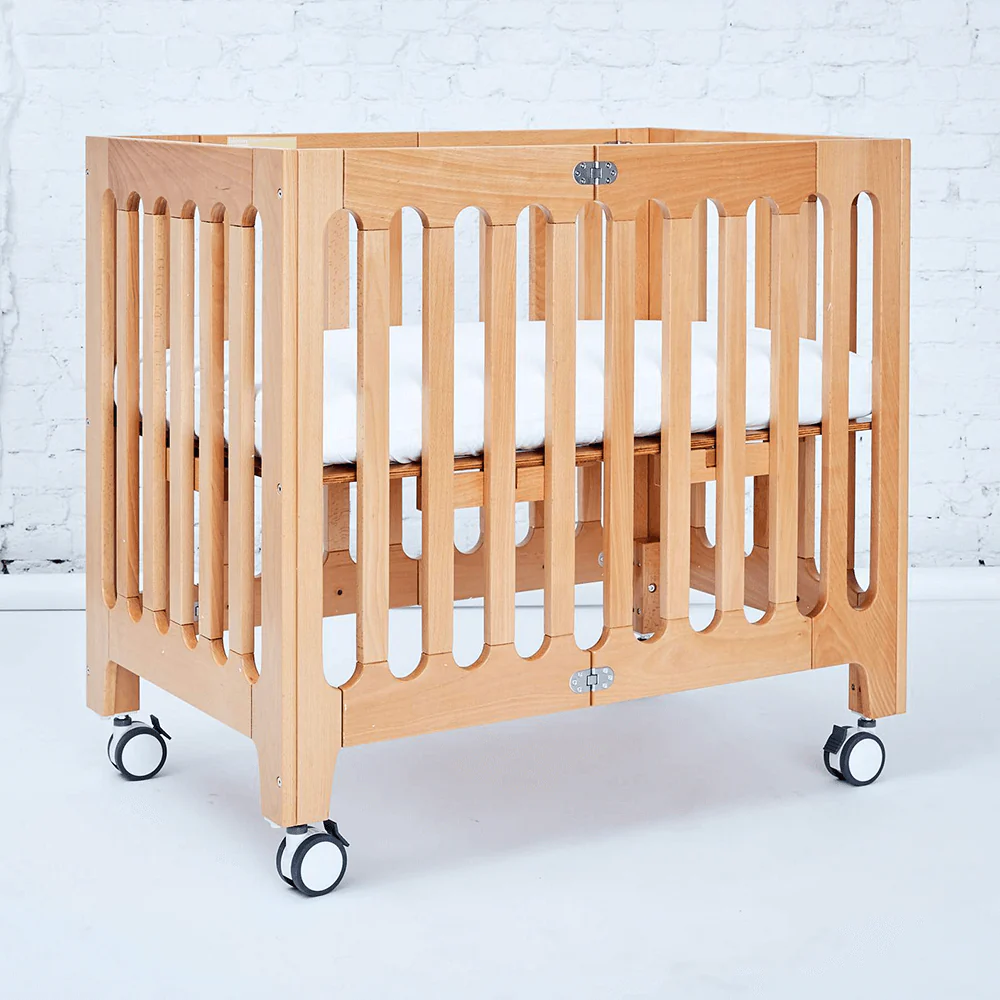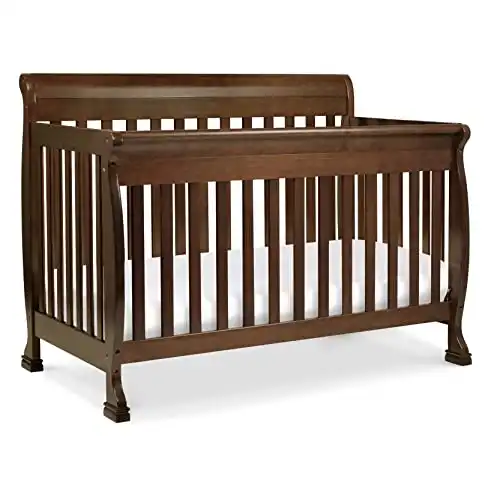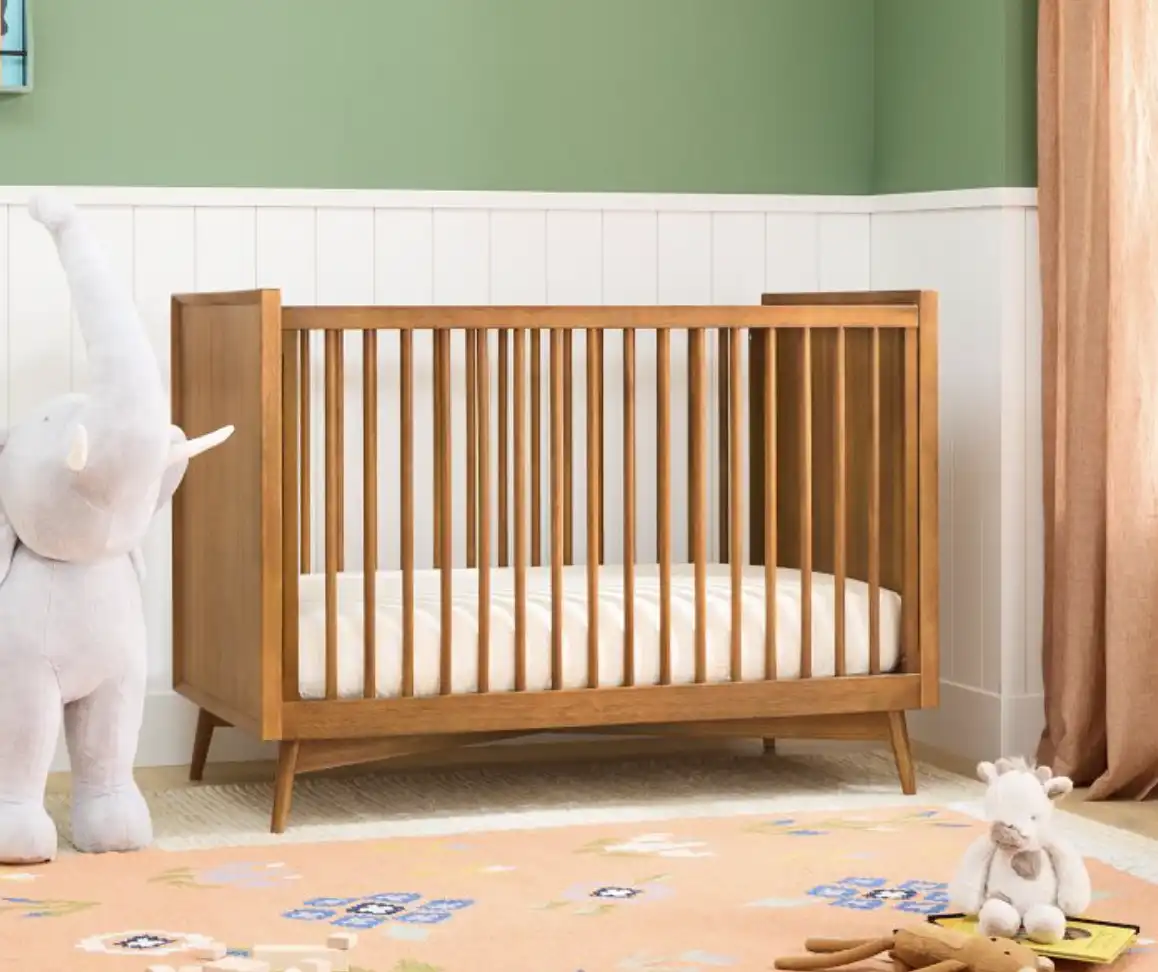Looking for the best non toxic crib to make the safest and healthiest sleep space possible for you baby? Here are 7 beautiful options to pick from in 2023.
I won’t lie, when I had my first child looking for non-toxic furniture was not even on my radar. It wasn’t something I considered in the slightest, to be completely honest.
However, after a bout of unexplained skin rashes, eczema, and allergies that we have since healed, I am a lot more conscious of the materials and products we bring into our home.
While I wasn’t able to go back in time and buy one of these best nontoxic baby cribs, I did make sure that I bought a non-toxic mattress and a non-toxic bed frame for their big kid beds!
It goes without saying that choosing the right crib for your baby is one of the most important decisions you’ll make as a new parent.
Not only does it need to be comfortable and functional, but it also needs to be safe and non-toxic. That’s why today I thought we’d explore this topic in this article.
Let’s talk about why choosing a non-toxic crib is so important for your baby’s health and safety. We’ll also provide you with a list of the best non-toxic cribs on the market, so you can make an informed decision when it comes to your little one’s sleeping environment.
This post may contain affiliate links.
Table of Contents
Use these quick links to navigate this blog post on non toxic cribs:
- Common Toxic Materials Found in Cribs
- How To Choose a Non-Toxic Crib
- Certifications To Look For On a Non Toxic Crib
- 7 Top Non Toxic Cribs on The Market
- How To DIY a Crib
- Non Toxic Crib FAQ
Common Toxic Materials Found in Cribs
Unfortunately, many cribs on the market today contain toxic materials that can be harmful to your baby’s health.
Some of the most common toxins found in cribs include formaldehyde, phthalates, and lead.
As I quickly discovered, these toxins can cause a wide range of health problems, from skin rashes to allergies and everything in between.
In particularly bad cases, they can even lead to more serious issues like developmental delays and cancer!
So how can you identify some of these common culprits? Well, unfortunately, there is no easy shortcut to this. You just have to know some of the common materials that are used in cribs that often contain these toxins.
Here is the rundown:
- Phthalates: These are plasticizers that are commonly used in crib mattresses and other baby products. They have been shown to potentially cause developmental problems, asthma, and other health issues.
- Formaldehyde: This is a chemical that is used in many different products, including some crib mattresses. It can cause respiratory problems, skin irritation, and other health issues.
- Polyurethane foam: This is a type of foam that is often used in crib mattresses. It can release toxic chemicals into the air, which can cause respiratory problems and other health issues.
- Vinyl: This is a type of plastic that is often used in crib mattresses It can cause respiratory problems and other health issues.
- Lead: This is a heavy metal that can be found in some crib mattresses and cribs. In excess, it can cause lead poisoning, which can lead to developmental problems, learning disabilities, and other health issues.
- Flame retardants: These chemicals are often used in crib mattresses, covers, and begging to make them less flammable. However, they can cause a range of health problems, including cancer, reproductive problems, and developmental delays.
- PVC: A major source of phthalates, this is a type of plastic that is often used in crib mattresses, toys, and decorations. It can release toxic chemicals into the air, which can cause respiratory problems and other health issues.
These chemicals can be dangerous — especially to little lungs and developing bodies.

How To Choose a Non-Toxic Crib
If you want to avoid all those nasty toxins, there are a few factors you need to consider when choosing your little one’s crib. Here are some of the criteria I would use to choose a non-toxic baby crib:
- Materials: You want a crib that is made using natural materials like solid wood, bamboo, or organic cotton. Avoid synthetic materials like vinyl or polyurethane foam, which can contain toxic chemicals.
- Finishes: Look for cribs with non-toxic finishes such as water-based paints or natural oils. Avoid cribs with finishes that contain volatile organic compounds (VOCs) as these can be harmful to your baby’s health.
- Certifications: Look for cribs that have been certified by independent organizations like Greenguard Gold or Oeko-Tex. These certifications ensure that the crib meets strict standards for safety and environmental impact.
- Design: Go for a crib that has a simple design without any extra features or decorations. This makes it not only easier to clean but also less likely to contain toxic chemicals.
- Age range: Go for cribs that can be used for a longer period of time. This will reduce the amount of waste you generate during disposal. Plus, you get to save money in the long run!
- Price: Non-toxic cribs can be a bit more expensive than traditional cribs. So try to find an option that fits your budget but still meets your safety standards.
- Safety standards: Look for cribs that meet safety standards set by organizations like the Consumer Product Safety Commission (CPSC) or the Juvenile Products Manufacturers Association (JPMA). These standards ensure that the crib is safe for your baby to use.
Here’s an overview of some common certifications for non-toxic cribs:
- Greenguard Gold: This certification ensures that the crib has been tested for over 10,000 chemicals and meets strict standards for indoor air quality and chemical emissions.
- OEKO-Tex: This ensures that the crib meets strict standards for harmful substances like heavy metals and formaldehyde.
- CertiPUR-US: This certification ensures that the foam used in the crib mattress is free from harmful chemicals.
- Global Organic Textile Standard (GOTS): This certification ensures that the crib meets strict standards for organic materials and environmental impact.
- Forest Stewardship Council (FSC): For wooden cribs, this ensures that the wood used in the crib comes from responsibly managed forests.
7 Top Non Toxic Cribs on the Market
1. Nestig The Wave Crib – Most Trendy
The Wave Crib, inspired by the movement of the ocean, converts from a mini crib, to full crib, to toddler bed. Its lockable wheels make it a breeze to move from room to room without compromising safety. All of this in an organically shaped, modern design that will fit in (or more likely stand out) wherever it goes.
The Nestig Wave Crib is made from solid beechwood and features a unique wave design that is both stylish and functional.
It has a non-toxic finish and is designed to meet strict safety standards. This crib is also designed to grow with your child, with adjustable mattress heights and the ability to convert into a toddler bed.
Key features:
- Unique wave design
- Converts from a mini crib to a full crib to a toddler bed
- Comes with lockable wheels
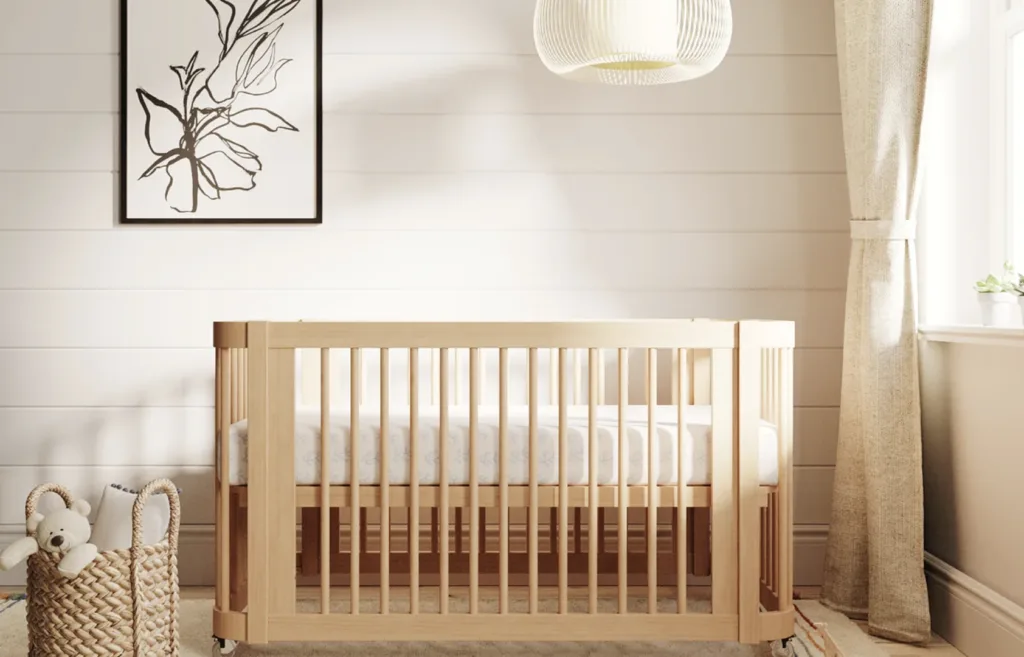
Pros and Cons:
Pros:
- Low mattress setting
- Heirloom quality
- Meets safety standards
- Made from solid wood
- Comes with mini crib mattress (you can pay $129 to upgrade to a higher quality one)
- Can add on a crib-size mattress for a fee
- Includes conversion kit to full crib
- Includes conversion kit to toddler bed
Cons:
- A little expensive
- Limited color options (2 colors available)
- Slower to ship
- May not be everyone’s style preference
- Has a bulky look as a toddler bed
2. Savvy Rest Oeuf Crib – Cleanest Materials
The beautiful Oeuf Crib is simple but versatile, and made to strict environmental standards. Slim side rails create a light, airy feel. As is standard for European cribs, Oeuf uses fixed rails to ensure maximum strength and safety.
The Savvy Rest Oeuf Crib is made from solid birch and features a modern, minimalist design. It has a gorgeous non-toxic finish.
This crib is made from locally sourced wood in Latvia and is Greenguard Gold certified.
It is also designed to be eco-friendly with a very low carbon footprint as all the wood waste and finishing materials are recycled and it is packaged in recycled cardboard.
Key features:
- Modern design that converts from crib to toddler bed
- Non-toxic finish
- Made of solid birch
Pros and Cons:
Pros:
- Stylish design
- Non-toxic materials
- Meets safety standards
- Made from solid wood
- Does not come with the conversion kit
Cons:
- Expensive
- Limited color options (3 colors available)
- You have to call them to purcahse the conversion kit
3. Babyletto Yuzu – Grows With Baby
Bassinet? Crib? How about both? The innovative Yuzu 8-in-1 Convertible All-Stages Crib seamlessly switches from bassinet to our transitional midi size and then to a standard full-size crib and junior bed, with all conversion kits included.
This crib is made from sustainable New Zealand pine and features a modern, geometric design.
It has a non-toxic finish and meets strict safety standards. The Babyletto Yuzu Crib is designed to be versatile, with the ability to convert into a toddler bed and day bed.
Key features:
- Modern 8-in-1 convertible design
- Made of solid New Zealand pine wood
- Non-toxic finish that meets safety standards
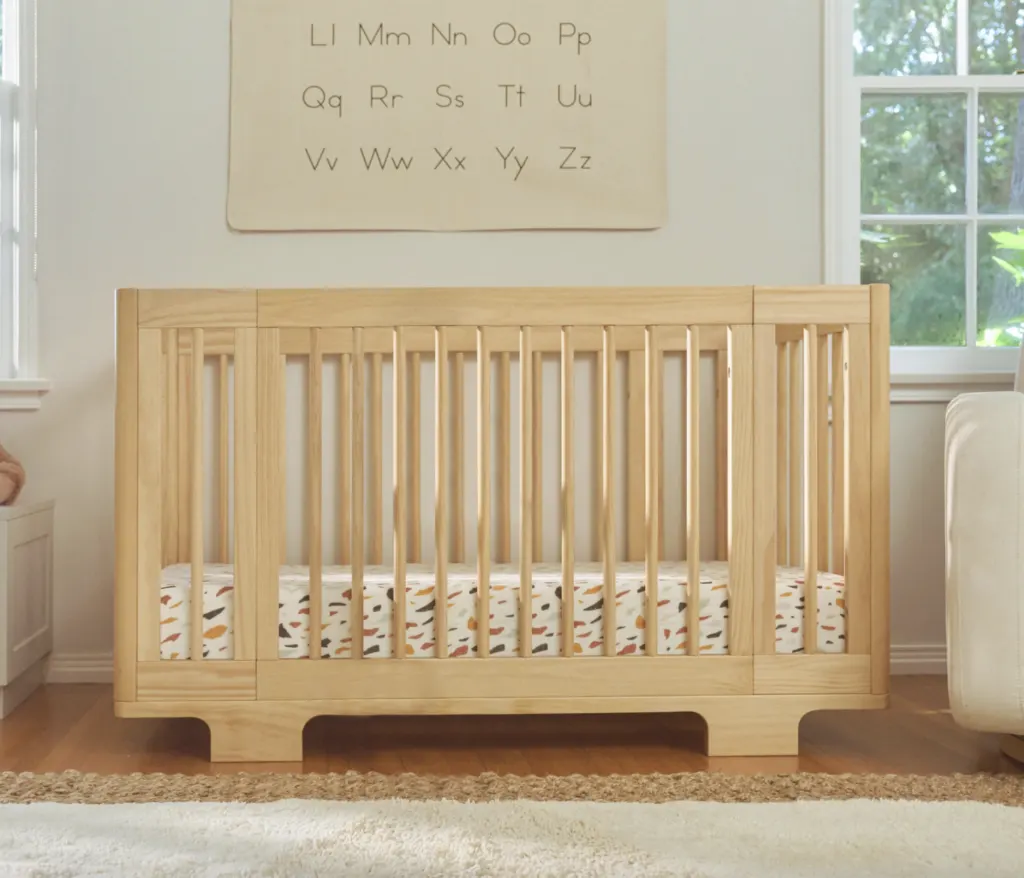
Pros and cons:
Pros:
- Stylish design
- Designed to meet safety standards
- Made from sustainable materials
- Affordable
- All conversion kits are included at no additional expense
- Available on Amazon for quick shipping
Cons:
- Limited color options (3 colors available, 2 colors on Amazon)
4. Bloom Alma Grow – Most Compact
Built to last, all alma cribs are beautifully constructed with American beech solid-wood only, no MDF, sourced from sustainable forests and backed by a 1 year warranty.
The Bloom Alma Grow is made from solid wood. It comes with a modern, compact design that is perfect for small spaces.
You’ll love its non-toxic finish as well as the fact that it is built to be super easy to use.
This crib also has a simple folding mechanism that allows you to conveniently store it away when not in use.
This is a great option for your baby’s nursery. It comes with a non-toxic crib mattress but does have some cons to it, as we will discuss below.
Key features:
- Converts from bassinet to crib to toddler bed
- Lockable wheels
- Compact fold for storage
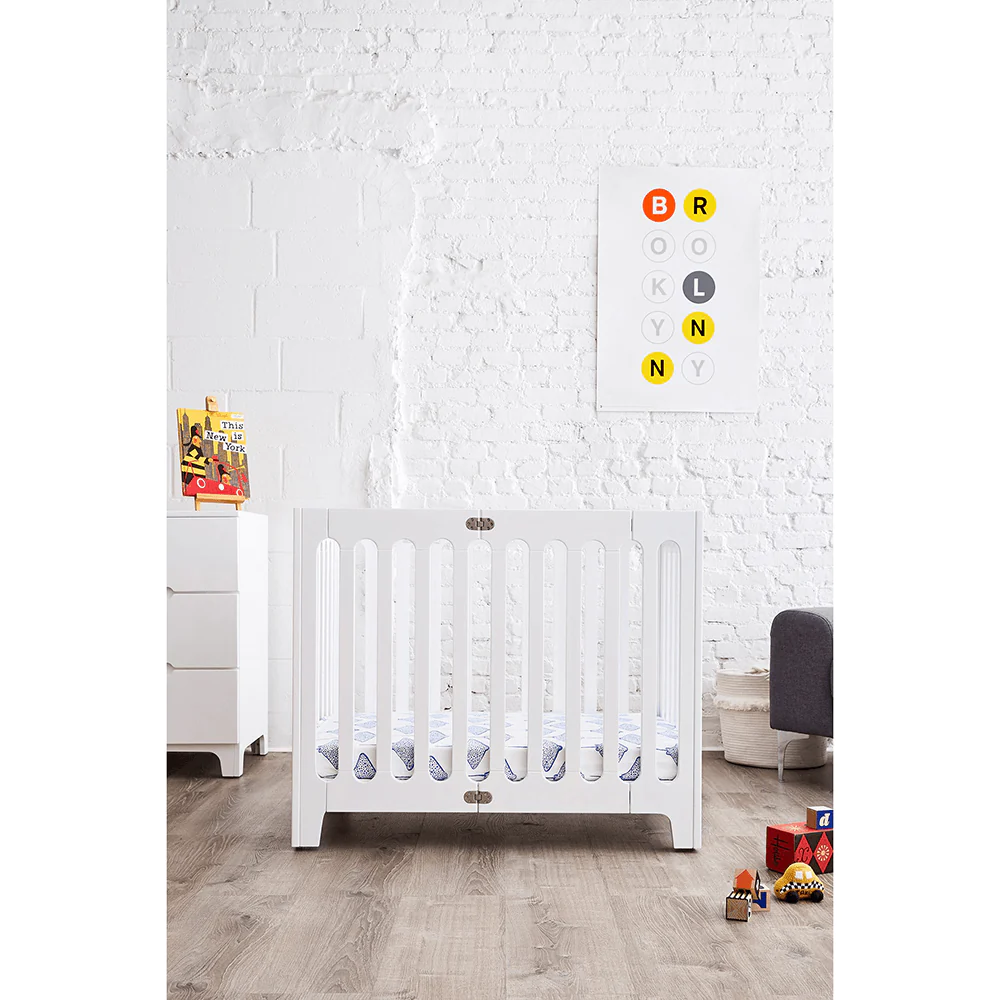
Pros and Cons:
Pros:
- Stylish design
- Compact size – good for small spaces
- Easy to store
- Made from solid wood
- Mattress included
Cons:
- Limited color options (3 available)
- Wheels may not be for everyone
- Design style may not be for everyone
- Extension kit sold separately
5. Davinci – Most Affordable
This crib has undergone rigorous scientific testing for over 10,000 chemical emissions and VOCs. It contributes to cleaner indoor air, creating a healthier environment for your baby to sleep, play, and grow.
A gorgeous yet affordable non-toxic crib option, the Davinci Kalani 4-in-1 Convertible crib is made using sustainable New Zealand pine.
This is a great option if you are on a budget. And the good thing about it is that it comes with all of the conversion kits you need.
It features a classic, timeless design that you will instantly fall in love with. It has a non-toxic finish and is designed to be accessible to most families.
Key features:
- Converts from crib to toddler bed to daybed
- Made of New Zealand pine wood
- Meets safety standards
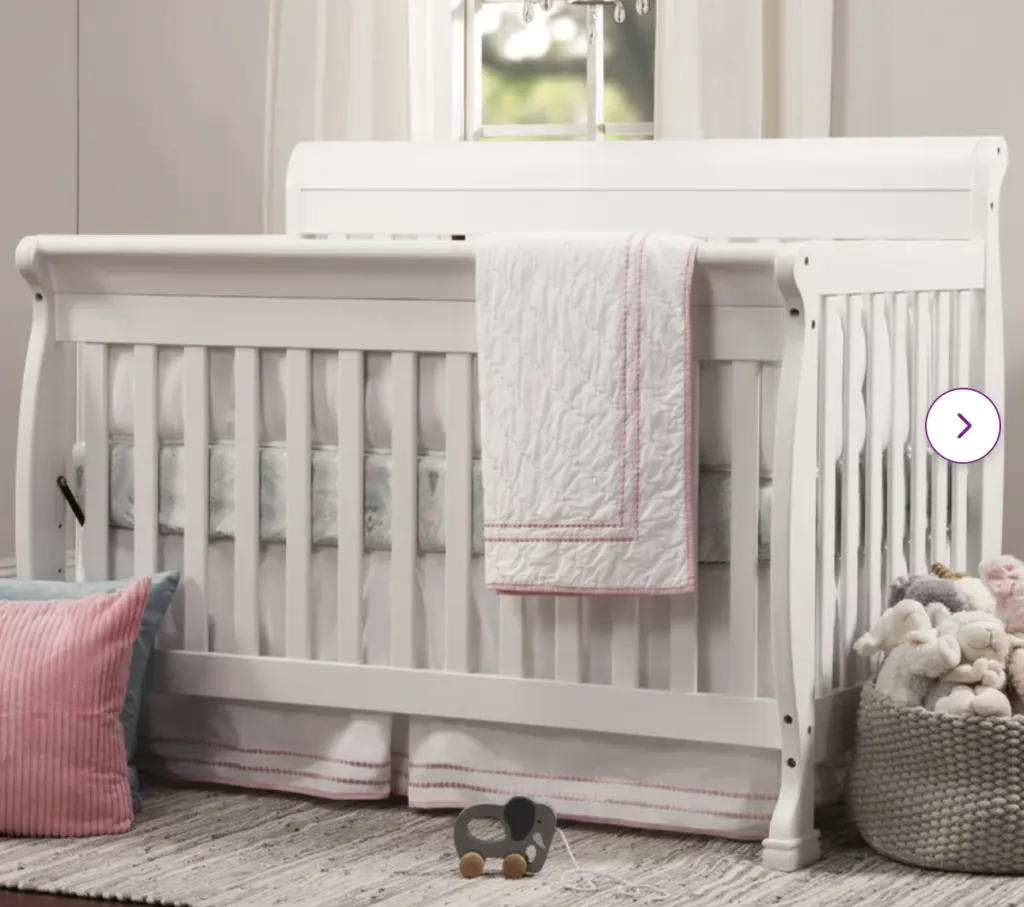
Pros and Cons:
Pros:
- Grow-with-me-design
- Non-toxic materials
- Made from sustainable materials
- Very affordable
- Available on Amazon for fast shipping
- Available on Wayfair with 1-day shipping
- Most color options (7 colors available)
Cons:
- Not as stylish as other cribs on this list
Shop DaVinci on Amazon | Shop DaVinci on Wayfair
6. Green Cradle – Biggest Investment
The gratitude slat crib is a classic simple modern design, handcrafted of all solid-wood and is made in the USA.
If you have been looking for an amazingly high-quality crib for your little one, this is it. The Green Cradle Gratitude Slat crib is made from the finest solid wood.
You can pick between brown maple, red oak, hard maple, cherry, and walnut.
You also have the option of getting it with an oil finish or unfinished, optional toddler rail, daybed conversion, full bed conversion, and more.
All these extra options make each crib extremely unique, something that a lot of parents appreciate.
Key features:
- Timeless design
- Non-toxic finish
- Highly customizable designs
Pros and cons:
Pros:
- Multiple color options
- Highly customizable
- Non-toxic materials
- Made from solid wood
- Made to order
Cons:
- Expensive
- May be quite heavy depending on your choice of wood
- Slow shipping (13+ weeks)
Customize your crib at Green Cradle
7. West Elm – Most Stylish
From newborn to toddler, this crib has two mattress heights and conveniently converts to a toddler bed with the conversion kit (sold separately). Made from sustainably sourced wood and covered in child-safe finishes, this stylish crib is built to last.
This crib is made from solid wood and features a mid-century modern design. It has a non-toxic finish and a beautiful design.
The West Elm Crib is designed to be stylish, with a sleek look that will complement any nursery decor.
Key features:
- Mid-century modern design
- Converts from crib to toddler bed
- Made of solid wood
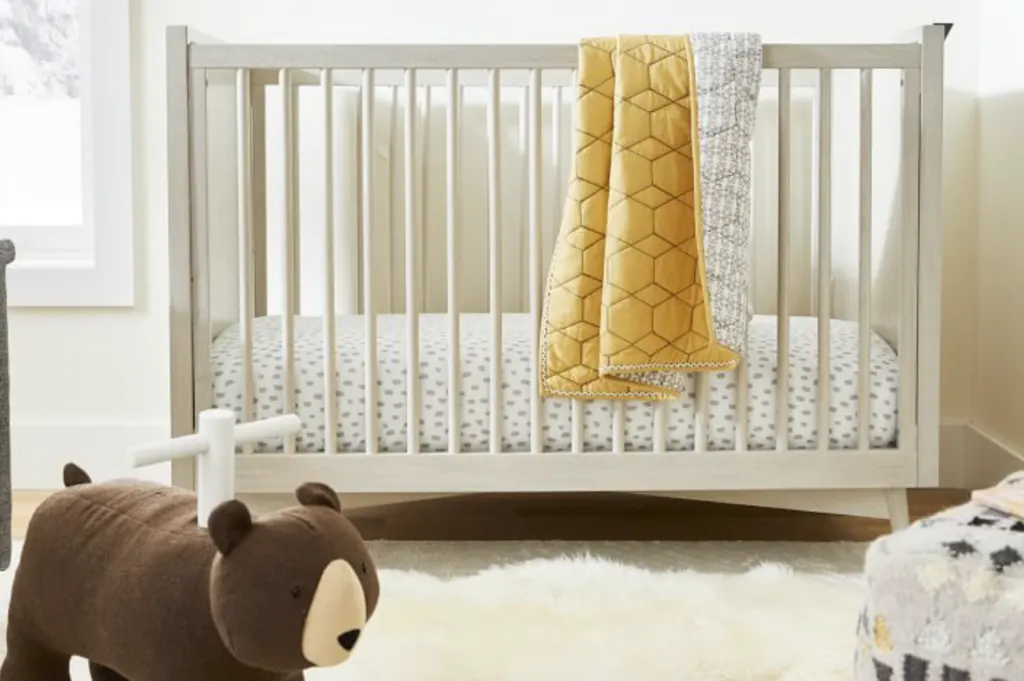
Pros and cons:
Pros:
- Stylish design
- Non-toxic materials
- Meets safety standards
- Made from solid wood
- Affordable
- Comes in 5 colors
Cons:
- On sale so may be going out of stock soon
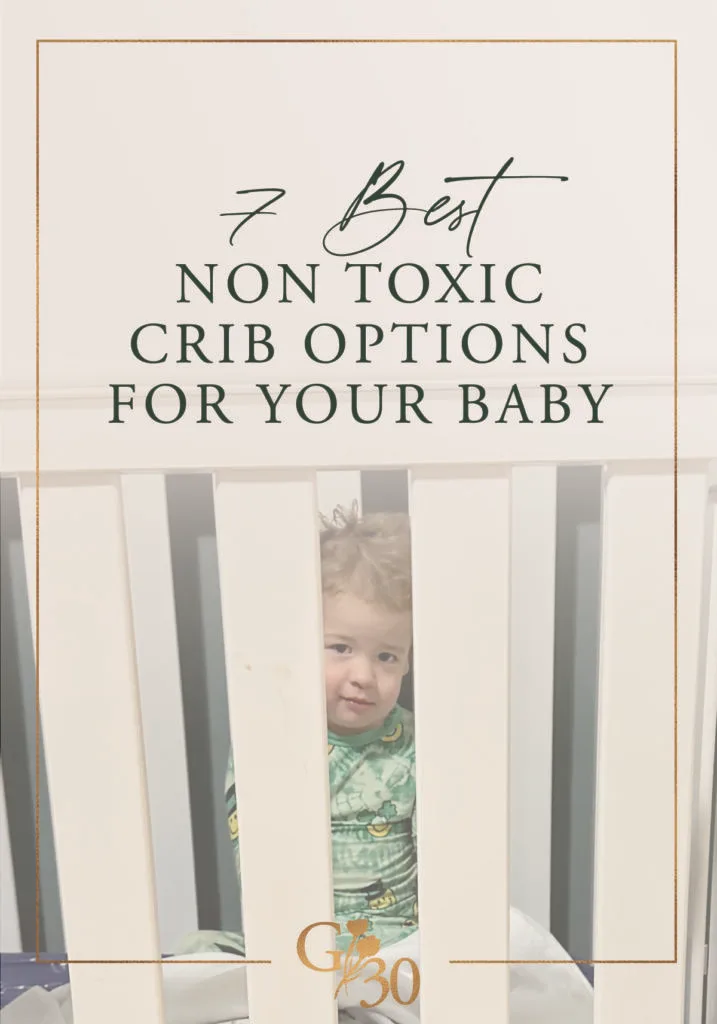
DIY Non Toxic Crib Options
So you want to try building your own DIY non-toxic crib? Well, here are some suggestions that will help you accomplish this using safe materials:
Materials to avoid:
There are certain materials that you want to stay away from when building a crib.
For example, don’t use any pressure-treated wood, which contains harmful chemicals like arsenic and chromium.
Also avoid using MDF or particleboard, which can contain formaldehyde.
Here are more materials to avoid:
- Pressure-treated wood: This type of wood contains harmful chemicals like arsenic and chromium.
- MDF or particleboard: These materials can contain formaldehyde.
- Synthetic or recycled materials: Avoid using these materials in your crib.
- Plastic: Avoid using plastic in your crib as it can contain harmful chemicals like BPA.
- Paints and finishes with VOCs: These can release harmful chemicals into the air.
Materials to use:
Generally, you want to stick to using solid wood that is sustainably sourced and free from toxic chemicals.
Look for FSC-certified wood or reclaimed wood. Also, consider using natural finishes like beeswax or linseed oil.
Here is a summary of materials to use when building a non-toxic crib:
- Use solid wood that is sustainably sourced and free from toxic chemicals. Look for FSC-certified wood or reclaimed wood.
- Use natural finishes like beeswax or linseed oil.
- Use organic fabrics for bedding and other accessories.
- Use non-toxic adhesives like wood glue.
- Use metal hardware instead of plastic hardware.
Building the crib:
Finally, here are some tips and tricks that will help you build the best non-toxic DIY crib!
- DIY crib plans: There are many DIY crib plans available online that use safe materials and are easy to follow. Before using any of them, ensure that they are safe to use and try to stick to the recommendations outlined here.
- Avoid decorative cutouts: Avoid cribs with headboards and footboards with pretty decorative cutouts, which are prohibited by the CPSC.
- Avoid drop-side cribs: There is a reason why you should always pass on a hand-me-down drop-side crib! It is unsafe for your baby.
How to maintain a non-toxic crib:
Whether you bought it or you built it, proper maintenance is the key to getting the most use out of your non-toxic crib.
Here are a few things you need to do:
- Clean regularly: Clean your crib regularly with a damp cloth and mild soap. Avoid using harsh chemicals or cleaners that can leave behind harmful residues.
- Air it out: Air out your crib mattress regularly to prevent the buildup of mold and mildew.
- Pick organic bedding: Use organic bedding made from natural materials like cotton or wool.
- Avoid plastic: Avoid using plastic toys in your crib as they can contain harmful chemicals like BPA.
- Register your crib: If your crib is store-bought, check for recalls to ensure that it is always safe for your baby to use. You should also do this regularly for all your other baby products to ensure they are safe for your baby.
FAQs
Are IKEA cribs non-toxic?
Yes, most IKEA cribs are non-toxic.
Whether it is an IKEA GULLIVER, IKEA Sniglar, or any other type of IKEA baby crib, a lot of them are made of materials and finishes that are non-toxic.
The brand has been one of a lot of parents’ favorites when it comes to buying baby nursery furniture.
What if my current crib is not non-toxic?
If your current crib is not non-toxic, consider replacing it with a non-toxic option.
You can also take steps to make your current crib safer by using a non-toxic mattress and bedding, avoiding decorative cutouts and drop-side cribs, and using natural finishes.
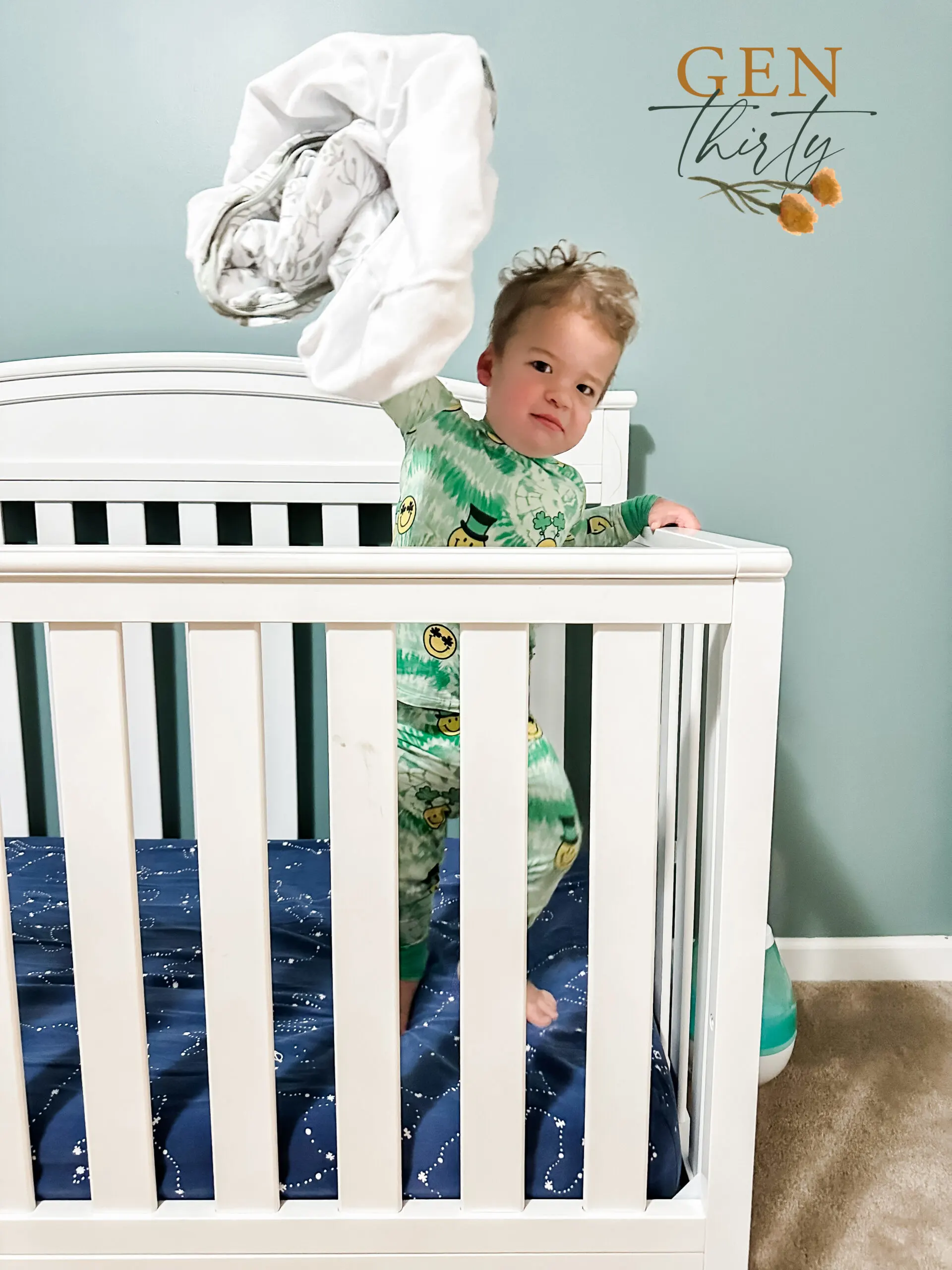
What are the common materials used in non-toxic cribs?
Common materials used in non-toxic cribs include solid wood, metal, and natural fibers.
Solid wood is a popular choice because it is durable, sturdy, and can be finished with non-toxic paints or stains. Oak, maple, and birch are commonly used types of wood.
Metal cribs, typically made from steel or iron, are also a good option as they are long-lasting and easy to clean.
Natural fibers, such as cotton and wool, are often used for crib mattresses and bedding. These materials are breathable, hypoallergenic, and free from harmful chemicals.
How can I tell if a crib is non-toxic?
Look for cribs that are labeled as “non-toxic,” “chemical-free,” or “eco-friendly.”
However, it’s important to note that these labels are not always regulated and may not always be accurate.
To be sure, research the materials used in the crib to see if they are known to contain harmful chemicals.
For example, some paints and finishes may contain volatile organic compounds (VOCs), which can be harmful to a baby’s health.
You should also look for certifications from third-party organizations such as GREENGUARD gold certification and others highlighted in this guide.
Are non-toxic cribs more expensive than traditional cribs?
Non-toxic cribs can be more expensive than traditional cribs. However, the cost can vary widely depending on the brand and materials used.
For example, solid wood cribs from Green Cradle are among the most pricey, but other brands like bloom and West Elm offer similar, more affordable options.
Some non-toxic cribs may have additional features such as adjustable heights or convertible options, which can also affect the price.
However, investing in a non-toxic crib is worth considering as it can provide peace of mind and protect your baby’s health.
What are some additional safety measures parents should take when using a non-toxic crib?
Parents should ensure that the crib meets all safety standards, such as those set by the Consumer Product Safety Commission (CPSC).
Check that the slats are no more than 2 3/8 inches apart to prevent the baby’s head from getting trapped, and make sure that there are no loose or missing parts.
Regularly check the crib for any damage or wear, and replace any damaged parts immediately.
Additionally, parents should ensure that the mattress fits snugly in the crib and that there are no gaps that could pose a suffocation risk.
Use a firm mattress and avoid using any pillows, blankets, or soft toys in the crib until the baby is at least one year old.
Final Thoughts on the Best Non Toxic Crib
Choosing a non-toxic crib is important for your baby’s health and safety. This blog post discussed the importance of choosing a non toxic crib and the seven best options available right now.
As we have seen, harmful chemicals found in some cribs can cause respiratory problems, skin irritation, and other health issues.
When choosing a crib, I highly recommend going for one made of solid wood that is sustainably sourced and free from toxic chemicals.
Ensure that it also uses natural finishes like beeswax or linseed oil instead of other paints and avoid synthetic materials.
I hope that this guide helps you make an informed decision when choosing a non-toxic crib for your baby! Good luck!
Home and Nursery
- 12 Best Split Screen Baby Monitors [2023]
- Non-Toxic Baby Pool Options For Kids [2023]
- 20 Best Rocking Chairs and Gliders For a Small Nursery [2023]
- The 20 Best Blackout Curtains For Your Nursery [2023]
- 10 Best Nursery Chairs For Small Spaces [2023]
- Top 8 Best Non Toxic Baby Swing Options [2023]
- Best Baby Swing for Reflux – 7 Picks [2023]
- 6 Best Organic Cotton Crib Sheets [2023]
- 8 Non-Toxic Couches For a Healthy Living Room
- The 20 Best Blackout Curtains For Your Nursery [2023]
- 10 Best Baby Activity Table Picks (2023)
- 9 Best Baby Play Gym Picks (2023)
- 7 Best Baby Bath Seat Picks (2023)
- 10 Best Cheap Baby Monitor Options 2023
- 8 Best Fans For a Nursery and Baby’s Room [2023]
- 9 Best Bassinet For Breastfeeding – 2023 Picks
- The Best Bassinet For Small Spaces – Top 10 [2023]
- 11 Best Natural Baby Laundry Detergent Picks
- 8 Best Non Toxic Crib Mattress Picks
- Best Organic Nursing Pillow (5 Top Picks)
- 8 Best Non Toxic Crib Mattress Picks
- 9 Top Bathtub for Toddlers Picks (2023)
- 7 Best Non Toxic Crib Options 2023

